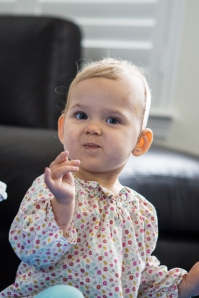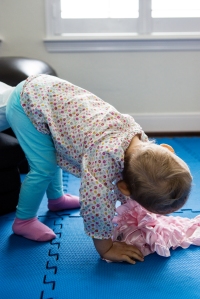The meeting with the neurosurgeon prior to the surgery described the treatment scenarios on a scale of least invasive to most invasive, along with a likelihood of success in Luna’s specific case. The chosen path was not the most invasive, leaving a portion of her left hemisphere connected and functioning with the hopes it is not involved in seizure onset. This decision was based on experience and the best medical science available today. It was not a mathematical formula with a guaranteed outcome, but rather a first step. One that if successful, leaves her the most natural motor function possible. If you didn’t read her initial story, you can find it here.
On November 6, Luna underwent what is called a TPO resection/disconnection in her left hemisphere. A known consequence is significant visual field cut in both eyes on the right side, a dense right sided hemianopsia. The actual procedure went very well and Luna recovered quickly. Here is a picture of good news from the waiting that day (Savanna was not particularly photogenic this day!)
Luna like most in this immediate time following surgery, is quite unhappy often. She doesn’t understand what happened to her or why. Her head itches, and probably hurts, but she can’t tell us in a way we immediately understand. She cries, and we do what all parents do, we just try to make it better any way possible. Her behavior and demeanor reminds me so much of Savanna during these days. I wish the pertinent doctors could be more aware of what this is like. When you try to speak with them about this, they really just don’t seem to care or have anything to help in the way of guidance, wisdom, or advice. I have come to realize they just don’t really know how hard it can be; how exhausting; how stressful. It is not to a fault in any way, it is just reality. You just can’t know unless you live through it personally.
Maria is returning to Norway completely emotionally drained, mentally exhausted, and physically hurting from holding and carrying Luna far more than you would ever carry or hold a normal 19 month-old.
The thought of being on a couple of airplanes for nearly 18 hours is just daunting to me, but she is determined.
So how is Luna?
The incision site looks great. She healing physically very well. She is not experiencing any complications.
Luna is much more calm overall. She is more focused and engaged with her environment.
She is changing rapidly during this time of recovery.
Some noticeable suspect activity has been seen. Luna needs more time to heal before officially ruling on this suspect activity, and a chance still exists that this activity will dissipate on its own.
She has some sensory processing issues she needs to work through, a process very difficult with the constant disturbance in her brain. Now she has a real chance to overcome these challenges, and in the short two weeks post-op we are already seeing these changes.
Luna has to tell us what she needs, metaphorically speaking.
Prior to the surgery, I worked and worked with Luna to stand and take steps. The hypotonia in her feet and legs is significant. She stands but with locked legs, and muscle grading is poor – much like our Savanna experienced. After surgery, she is so much more focused and able to “think” about something such as walking. Here is a short video that is just amazing. I could not have done this with her a couple of weeks ago, without more or less carrying her through the process. She would have tried to turn left circles the entire time and cried while doing it, or as Maria calls it ‘protesting’. Now, she is very motivated.
What do you feel as a parent in this situation? What do you do next?
Well, first, you have to learn to wait. This is harder than it sounds, because the academic body of evidence is growing to act sooner rather than later with pediatric cases.
As a parent, your world hinges on the surgical success, something that can take some time to appropriately cast judgement.
You research others’ stories with an obsessive compulsion that can render you insane. With red eyes, you seek out that other child who looks just like yours; has seizures just like yours. What was their treatment path and outcome? How can I interpolate and extrapolate their path into mine? You fixate on their story, for better or for worse. But this is what we do as a parent of a child with intractable epilepsy in this ‘Google-centric’ world.
While not entirely healthy, you come up for air once in a while and find scholarly articles to educate yourself in an objective manner. Then you remember discussions with the pertinent doctors, the ones you put so much trust into already, and let their guidance help show the way. You go back and re-read diagnostic findings, again to help educate yourself.
You second guess every decision made in your child’s care. You realize that you cannot go back and relive anything, try anything differently, act differently or more quickly. This time has passed and all you have is the future, on a new path post-op.
To use a very American analogy… At this juncture, as a parent, you have left the college sports ranks and joined the professional athletes. When you run through the tunnel onto the pro playing field/court, the same game is very different. And as a pro, success means embracing this change. You have to expand your mind. You must adapt to a larger set of variables, more potential consequences, and then re-calibrate your mind with regard to what “success” really means. Going back to the college days, is no longer an option.
On top of all this brow-beating and compulsive ‘googling’, Maria has secured a work position here in Houston for the next couple of years and sold her beloved house in Norway. She returns to Norway today to finalize her move to the USA for employment and spend much needed time with her other daughter. We will get to see her again in the future and look forward to seeing Luna’s progress.




